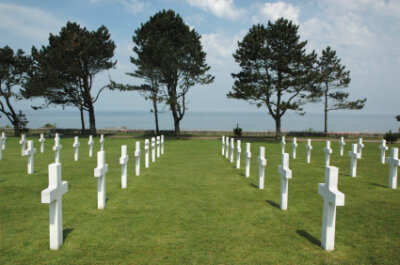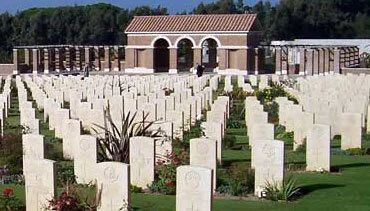Honoring America's Fallen Soldiers in Normandy
by Roy Stevenson
American Military Cemetery, Colleville, Normandy, FranceThe view from the top of the high, soft, sand dunes next to the American Military Cemetery at Colleville, Normandy, is great today. It’s a bright clear blue sky and I can see for miles. French fishing trawlers churn through the choppy, deep blue water, miles out to sea, leaving wide foaming wakes behind them. Gazing down across the long, deserted flat white expanse of Omaha Beach, I can see where the olive uniformed American soldiers debarked their landing craft, to shelter behind steel tetrahedrons, or sprint up the beach on D-Day, June 6, 1944.
Descending the sand dunes, I walk the long 500 meters down the gently sloping beach to the water’s edge. It’s dead low tide. I turn around, looking back up towards the dunes. I’m amazed at how far away they are. They would seem like they were miles away, especially to a young soldier armed to the teeth and heavily weighed down with equipment.
It must have been terrifying trying to sprint up the beach into the teeth of a hailstorm of machine gun, rifle, and mortar fire. Of the soldiers in the first few D-Day landing craft, 90% didn’t even make it up the beach. In my mind’s eye I fleetingly see chaos, patches of red blood-drenched sand, and a flickering image of a young soldier in a soaked green uniform. “I must have seen “Saving Private Ryan” once too many times”, I think self-consciously.
Deep in thought, I trudge back up the steep, uneven sand dunes to the American Military Cemetery and walk along row upon row of perfectly aligned white crosses, on the vast 172-acre, smooth, emerald green-grassed plateau. The 9,387 crosses are a stupefying sight. They radiate outwards in perfectly straight lines no matter what angle they are viewed from.
American Military Cemetery, Colleville, Normandy, FranceMost have the Latin cross inscribed on them, with an occasional Star of David. The writing engraved on the crosses tells heartrending stories. I read the names, ages, unit, state, and the date these young men were killed on. They come from 49 States of the Union, the District of Columbia and Guam. A 19-year old from Ohio, a 21-year old from Oklahoma; both died within a few days of the landings. They never got to live full and productive lives, get married, or have families.
I see crosses with Pennsylvania, Michigan, New York, and Washington marked on them. Paratroopers from the 81nd and 101st Airborne Divisions; infantrymen from other American divisions. Most young, no older than the students I have taught for the past 17 years. I am numbed—don’t know if I can hold back the tears.
I keep thinking there must be something I can do to honor them. Finally I mutter a brief prayer and say “thank you” to them—that’s the best I can do. I’m sorry they died not knowing their ultimate sacrifice to free enslaved Europe from the Nazi shadow would be successful. Searching for some consolation, I hope these soldiers would be pleased to know that so many people visit this place to remember them and their sacrifice. Maybe they might have thought it was worth it.
People around me walk slowly around dazed, as if in a trance. We avoid eye contact. Most people have moist eyes, and it’s not from the gentle wind blowing across the bluff. The intensity of the emotions this cemetery stirs up is stunning. There’s no noise except for the breeze in the Laurel, Cypress and Holly Oak trees lining the sides of the cemetery, adding a feeling of serenity to this emotionally overpowering place.
American Military Cemetery, Colleville, Normandy, FranceThe Chapel is constructed from a beautiful white limestone. “I Give Unto Them Eternal Life and They Shall Never Perish” is written across the front of the black and gold antique altar. Walking towards the exit I stop in front of the 22-foot tall bronze statue, titled “The Spirit of American Youth Rising from the Waves”. Even though I have never done any military service in New Zealand or my new adopted country, the United States of America, I salute the statue, and leave.
Roy Stevenson is a freelance travel writer and photographer based in Seattle, Washington. With more than 700 articles published in 160 regional, national, and international magazines, newspapers, in-flights and online travel magazines, Roy is one of the most prolific travel writers in the U.S.A. His work has appeared in the U.S.A., Canada, England, Scotland, Ireland, Australia, New Zealand and South Africa. He writes on travel and culture, history, art, military history, military vehicles, writing, communications, health, fitness, running, triathlons, sports and film festival reviews. He writes the monthly destination travel column for 48 Degrees North yachting magazine. To view more of Roy Stevenson’s travel articles go to www.Roy-Stevenson.com
photos via the author and istockphoto.com





